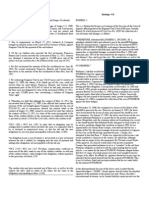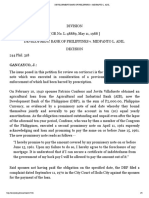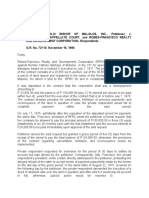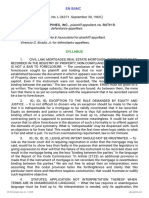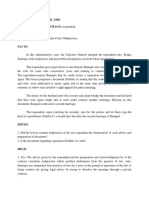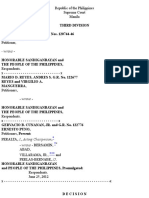0 ratings0% found this document useful (0 votes)
48 viewsBaldomero Inciong, JR., Petitioner, vs. Court of Appeals and Philippine Bank of Communications, Respondents
Baldomero Inciong, JR., Petitioner, vs. Court of Appeals and Philippine Bank of Communications, Respondents
Uploaded by
georjalynjoyThis document is a legal case summary from the Supreme Court of the Philippines regarding a petition for review of a decision from the Court of Appeals affirming a ruling from a regional trial court. The regional trial court found the petitioner, Baldomero Inciong Jr., to be solidarily liable for a 50,000 peso promissory note he co-signed. The Supreme Court denied the petition, finding no reversible error in the lower courts' rulings that Inciong was liable for the full amount of the promissory note.
Copyright:
© All Rights Reserved
Available Formats
Download as DOCX, PDF, TXT or read online from Scribd
Baldomero Inciong, JR., Petitioner, vs. Court of Appeals and Philippine Bank of Communications, Respondents
Baldomero Inciong, JR., Petitioner, vs. Court of Appeals and Philippine Bank of Communications, Respondents
Uploaded by
georjalynjoy0 ratings0% found this document useful (0 votes)
48 views6 pagesThis document is a legal case summary from the Supreme Court of the Philippines regarding a petition for review of a decision from the Court of Appeals affirming a ruling from a regional trial court. The regional trial court found the petitioner, Baldomero Inciong Jr., to be solidarily liable for a 50,000 peso promissory note he co-signed. The Supreme Court denied the petition, finding no reversible error in the lower courts' rulings that Inciong was liable for the full amount of the promissory note.
Original Description:
evidence
Original Title
Inciong vs CA
Copyright
© © All Rights Reserved
Available Formats
DOCX, PDF, TXT or read online from Scribd
Share this document
Did you find this document useful?
Is this content inappropriate?
This document is a legal case summary from the Supreme Court of the Philippines regarding a petition for review of a decision from the Court of Appeals affirming a ruling from a regional trial court. The regional trial court found the petitioner, Baldomero Inciong Jr., to be solidarily liable for a 50,000 peso promissory note he co-signed. The Supreme Court denied the petition, finding no reversible error in the lower courts' rulings that Inciong was liable for the full amount of the promissory note.
Copyright:
© All Rights Reserved
Available Formats
Download as DOCX, PDF, TXT or read online from Scribd
Download as docx, pdf, or txt
0 ratings0% found this document useful (0 votes)
48 views6 pagesBaldomero Inciong, JR., Petitioner, vs. Court of Appeals and Philippine Bank of Communications, Respondents
Baldomero Inciong, JR., Petitioner, vs. Court of Appeals and Philippine Bank of Communications, Respondents
Uploaded by
georjalynjoyThis document is a legal case summary from the Supreme Court of the Philippines regarding a petition for review of a decision from the Court of Appeals affirming a ruling from a regional trial court. The regional trial court found the petitioner, Baldomero Inciong Jr., to be solidarily liable for a 50,000 peso promissory note he co-signed. The Supreme Court denied the petition, finding no reversible error in the lower courts' rulings that Inciong was liable for the full amount of the promissory note.
Copyright:
© All Rights Reserved
Available Formats
Download as DOCX, PDF, TXT or read online from Scribd
Download as docx, pdf, or txt
You are on page 1of 6
BALDOMERO INCIONG, JR., petitioner, vs.
COURT OF APPEALS and
PHILIPPINE BANK OF COMMUNICATIONS, respondents.
SYLLABUS
1. REMEDIAL LAW; EVIDENCE; PAROL EVIDENCE RULE; DOES NOT SPECIFY
THAT THE WRITTEN AGREEMENT BE A PUBLIC INSTRUMENT.- Clearly, the
rule does not specify that the written agreement be a public document. What is
required is that the agreement be in writing as the rule is in fact founded on "long
experience that written evidence is so much more certain and accurate than that
which rests in fleeting memory only, that it would be unsafe, when parties have
expressed the terms of their contract in writing, to admit weaker evidence to control
and vary the stronger and to show that the parties intended a different contract from
that expressed in the writing signed by them" [FRANCISCO, THE RULES OF
COURT OF THE PHILIPPINES, Vol. VII, Part I, 1990 ed., p. 179] Thus, for the
parol evidence rule to apply, a written contract need not be in any particular form, or
be signed by both parties. As a general rule, bills, notes and other instruments of a
similar nature are not subject to be varied or contradicted by parol or extrinsic
evidence.
2. CIVIL LAW; OBLIGATIONS; SOLIDARY OR JOINT AND SEVERAL OBLIGATION,
DEFINED.- A solidary or joint and several obligation is one in which each debtor is
liable for the entire obligation, and each creditor is entitled to demand the whole
obligation. [TOLENTINO, CIVIL CODE OF THE PHILIPPINES, Vol. IV, 1991 ed., p.
217] Section 4, Chapter 3, Title 1, Book IV of the Civil Code states the law on joint
and several obligations. Under Art. 1207 thereof, when there are two or more
debtors in one and the same obligation, the presumption is that the obligation is
joint so that each of the debtors is liable only for the proportionate part of the
debt. There is a solidary liability only when the obligation expressly so states, when
the law so provides or when the nature of the obligation so requires. [Sesbreo v.
Court of Appeals, G.R. No. 89252, May 24, 1993, 222 SCRA 466, 481.]
3. ID.; GUARANTY; GUARANTOR AS DISTINGUISHED FROM SOLIDARY
DEBTOR.- While a guarantor may bind himself solidarily with the principal debtor,
the liability of a guarantor is different from that of a solidary debtor. Thus, Tolentino
explains: "A guarantor who binds himself in solidum with the principal debtor under
the provisions of the second paragraph does not become a solidary co-debtor to all
intents and purposes. There is a difference between a solidary co-debtor, and a
fiador in solidum (surety). The latter, outside of the liability he assumes to pay the
debt before the property of the principal debtor has been exhausted, retains all the
other rights, actions and benefits which pertain to him by reason of the fiansa; while
a solidary co-debtor has no other rights than those bestowed upon him in Section 4,
Chapter 3, Title 1, Book IV of the Civil Code." [Tolentino, Civil Code of the
Philippines, Vol. V, 1992 ed., p. 502]
APPEARANCES OF COUNSEL
Emilio G. Abrogena for petitioner.
Teogenes X. Velez for private respondent.
D E C I S I O N
ROMERO, J .:
This is a petition for review on certiorari of the decision of the Court of Appeals
affirming that of the Regional Trial Court of Misamis Oriental, Branch 18,
[1]
which
disposed of Civil Case No. 10507 for collection of a sum of money and damages, as
follows:
"WHEREFORE, defendant BALDOMERO L. INCIONG, JR. is adjudged solidarily
liable and ordered to pay to the plaintiff Philippine Bank of Communications,
Cagayan de Oro City, the amount of FIFTY THOUSAND PESOS (P50,000.00),with
interest thereon from May 5, 1983 at 16% per annum until fully paid; and 6% per
annum on the total amount due, as liquidated damages or penalty from May 5, 1983
until fully paid; plus 10% of the total amount due for expenses of litigation and
attorney's fees; and to pay the costs.
The counterclaim, as well as the cross claim, are dismissed for lack of merit.
SO ORDERED."
Petitioner's liability resulted from the promissory note in the amount of P50,000.00
which he signed with Rene C. Naybe and Gregorio D. Pantanosas on February 3, 1983,
holding themselves jointly and severally liable to private respondent Philippine Bank of
Communications, Cagayan de Oro City branch. The promissory note was due on May
5, 1983.
Said due date expired without the promissors having paid their
obligation. Consequently, on November 14, 1983 and on June 8, 1984, private
respondent sent petitioner telegrams demanding payment thereof.
[2]
On December 11,
1984 private respondent also sent by registered mail a final letter of demand to Rene C.
Naybe. Since both obligors did not respond to the demands made, private respondent
filed on January 24, 1986 a complaint for collection of the sum of P50,000.00 against
the three obligors.
On November 25, 1986, the complaint was dismissed for failure of the plaintiff to
prosecute the case. However, on January 9, 1987, the lower court reconsidered the
dismissal order and required the sheriff to serve the summonses. On January 27, 1987,
the lower court dismissed the case against defendant Pantanosas as prayed for by the
private respondent herein. Meanwhile, only the summons addressed to petitioner was
served as the sheriff learned that defendant Naybe had gone to Saudi Arabia.
In his answer, petitioner alleged that sometime in January 1983, he was
approached by his friend, Rudy Campos, who told him that he was a partner of Pio Tio,
the branch manager of private respondent in Cagayan de Oro City, in the falcata logs
operation business. Campos also intimated to him that Rene C. Naybe was interested
in the business and would contribute a chainsaw to the venture. He added that,
although Naybe had no money to buy the equipment Pio Tio had assured Naybe of the
approval of a loan he would make with private respondent. Campos then persuaded
petitioner to act as a "co-maker" in the said loan. Petitioner allegedly acceded but with
the understanding that he would only be a co-maker for the loan of P5,000.00.
Petitioner alleged further that five (5) copies of a blank promissory note were
brought to him by Campos at his office. He affixed his signature thereto but in one
copy, he indicated that he bound himself only for the amount of P5,000.00. Thus, it was
by trickery, fraud and misrepresentation that he was made liable for the amount of
P50,000.00.
In the aforementioned decision of the lower court, it noted that the typewritten figure
"P50,000-" clearly appears directly below the admitted signature of the petitioner in the
promissory note.
[3]
Hence, the latter's uncorroborated testimony on his limited liability
cannot prevail over the presumed regularity and fairness of the transaction, under Sec.
5 (q) of Rule 131. The lower court added that it was "rather odd" for petitioner to have
indicated in a copy and not in the original, of the promissory note, his supposed
obligation in the amount of P5,000.00 only. Finally, the lower court held that even
granting that said limited amount had actually been agreed upon, the same would have
been merely collateral between him and Naybe and, therefore, not binding upon the
private respondent as creditor-bank.
The lower court also noted that petitioner was a holder of a Bachelor of Laws
degree and a labor consultant who was supposed to take due care of his concerns, and
that, on the witness stand, Pio Tio denied having participated in the alleged business
venture although he knew for a fact that the falcata logs operation was encouraged by
the bank for its export potential.
Petitioner appealed the said decision to the Court of Appeals which, in its decision
of August 31, 1990, affirmed that of the lower court. His motion for reconsideration of
the said decision having been denied, he filed the instant petition for review
on certiorari.
On February 6,1991, the Court denied the petition for failure of petitioner to comply
with the Rules of Court and paragraph 2 of Circular No. 1-88, and to sufficiently show
that respondent court had committed any reversible error in its questioned
decision.
[4]
His motion for the reconsideration of the denial of his petition was likewise
denied with finality in the Resolution of April 24, 1991.
[5]
Thereafter, petitioner filed a
motion for leave to file a second motion for reconsideration which, in the Resolution of
May 27, 1991, the Court denied. In the same Resolution, the Court ordered the entry of
judgment in this case.
[6]
Unfazed, petitioner filed a motion for leave to file a motion for clarification. In the
latter motion, he asserted that he had attached Registry Receipt No. 3268 to page 14 of
the petition in compliance with Circular No. 1-88. Thus, on August 7,1991, the Court
granted his prayer that his petition be given due course and reinstated the same.
[7]
Nonetheless, we find the petition unmeritorious.
Annexed to the petition is a copy of an affidavit executed on May 3, 1988, or after
the rendition of the decision of the lower court, by Gregorio Pantanosas, Jr., an MTCC
judge and petitioner's co-maker in the promissory note. It supports petitioner's
allegation that they were induced to sign the promissory note on the belief that it was
only for P5,000.00, adding that it was Campos who caused the amount of the loan to be
increased to P50,000.00.
The affidavit is clearly intended to buttress petitioner's contention in the instant
petition that the Court of Appeals should have declared the promissory note null and
void on the following grounds: (a) the promissory note was signed in the office of Judge
Pantanosas, outside the premises of the bank; (b) the loan was incurred for the purpose
of buying a second-hand chainsaw which cost only P5,000.00; (c) even a new chainsaw
would cost only P27,500.00; (d) the loan was not approved by the board or credit
committee which was the practice, at it exceeded P5,000.00; (e) the loan had no
collateral; (f) petitioner and Judge Pantanosas were not present at the time the loan was
released in contravention of the bank practice, and (g) notices of default are sent
simultaneously and separately but no notice was validly sent to him.
[8]
Finally, petitioner
contends that in signing the promissory note, his consent was vitiated by fraud as,
contrary to their agreement that the loan was only for the amount of P5,000. 00, the
promissory note stated the amount of P50,000.00.
The above-stated points are clearly factual. Petitioner is to be reminded of the
basic rule that this Court is not a trier of facts. Having lost the chance to fully ventilate
his factual claims below, petitioner may no longer be accorded the same opportunity in
the absence of grave abuse of discretion on the part of the court below. Had he
presented Judge Pantanosas' affidavit before the lower court, it would have
strengthened his claim that the promissory note did not reflect the correct amount of the
loan.
Nor is there merit in petitioner's assertion that since the promissory note "is not a
public deed with the formalities prescribed by law but x x x a mere commercial paper
which does not bear the signature of x x x attesting witnesses," parol evidence may
"overcome" the contents of the promissory note.
[9]
The first paragraph of the parol
evidence rule
[10]
states:
"When the terms of an agreement have been reduced to writing, it is considered as
containing all the terms agreed upon and there can be, between the parties and their
successors-in-interest, no evidence of such terms other than the contents of the written
agreement."
Clearly, the rule does not specify that the written agreement be a public document.
What is required is that agreement be in writing as the rule is in fact founded on
"long experience that written evidence is so much more certain and accurate than that
which rests in fleeting memory only, that it would be unsafe, when parties have
expressed the terms of their contract in writing, to admit weaker evidence to control and
vary the stronger and to show that the parties intended a different contract from that
expressed in the writing signed by them."
[11]
Thus, for the parol evidence rule to apply, a
written contract need not be in any particular form, or be signed by both parties.
[12]
As a
general rule, bills, notes and other instruments of a similar nature are not subject to be
varied or contradicted by parol or extrinsic evidence.
[13]
By alleging fraud in his answer,
[14]
petitioner was actually in the right direction
towards proving that he and his co-makers agreed to a loan of P5,000.00 only
considering that, where a parol contemporaneous agreement was the inducing and
moving cause of the written contract, it may be shown by parol evidence.
[15]
However,
fraud must be established by clear and convincing evidence, mere preponderance of
evidence, not even being adequate.
[16]
Petitioner's attempt to prove fraud must,
therefore, fail as it was evidenced only by his own uncorroborated and, expectedly, self-
serving testimony.
Petitioner also argues that the dismissal of the complaint against Naybe, the
principal debtor, and against Pantanosas, his co-maker, constituted a release of his
obligation, especially because the dismissal of the case against Pantanosas was upon
the motion of private respondent itself. He cites as basis for his argument, Article 2080
of the Civil Code which provides that:
"The guarantors, even though they be solidary, are released from their obligation
whenever by some act of the creditor, they cannot be subrogated to the rights,
mortgages, and preferences of the latter."
It is to be noted, however, that petitioner signed the promissory note as a solidary
co-maker and not as a guarantor. This is patent even from the first sentence of the
promissory note which states as follows:
"Ninety one (91) days after date, for value received, I/we, JOINTLY and
SEVERALLY promise to pay to the PHILIPPINE BANK OF COMMUNICATIONS
at its office in the City of Cagayan de Oro, Philippines the sum of FIFTY
THOUSAND ONLY (P50,000. 00) Pesos, Philippine Currency, together with interest
x x x at the rate of SIXTEEN (16) per cent per annum until fully paid."
A solidary or joint and several obligation is one in which each debtor is liable for the
entire obligation, and each creditor is entitled to demand the whole obligation.
[17]
On the
other hand, Article 2047 of the Civil Code states:
"By guaranty a person, called the guarantor, binds himself to the creditor to fulfill the
obligation of the principal debtor in case the latter should fail to do so.
If a person binds himself solidarily with the principal debtor, the provisions of Section
4, Chapter 3, Title I of this Book shall be observed, In such a case the contract is
called a suretyship." (Italics supplied.)
While a guarantor may bind himself solidarily with the principal debtor, the liability of a
guarantor is different from that of a solidary debtor. Thus, Tolentino explains:
"A guarantor who binds himself in solidum with the principal debtor under the provisions of the
second paragraph does not become a solidary co-debtor to all intents and purposes. There is a
difference between a solidary co-debtor, and a fiador in solidum (surety). The later, outside of
the liability he assumes to pay the debt before the property of the principal debtor has been
exhausted, retains all the other rights, actions and benefits which pertain to him by reason of
the fiansa; while a solidary co-debtor has no other rights than those bestowed upon him in
Section 4, Chapter 3, title I, Book IV of the Civil Code."
[18]
Section 4, Chapter 3, Title I, Book IV of the Civil Code states the law on joint and
several obligations. Under Art. 1207 thereof, when there are two or more debtors in one
and the same obligation, the presumption is that the obligation is joint so that each of
the debtors is liable only for a proportionate part of the debt. There is a solidarity liability
only when the obligation expressly so states, when the law so provides or when the
nature of the obligation so requires.
[19]
Because the promissory note involved in this case expressly states that the three
signatories therein are jointly and severally liable, any one, some or all of them may be
proceeded against for the entire obligation.
[20]
The choice is left to the solidary creditor
to determine against whom he will enforce collection.
[21]
Consequently, the dismissal of
the case against Judge Pontanosas may not be deemed as having discharged
petitioner from liability as well. As regards Naybe, suffice it to say that the court never
acquired jurisdiction over him. Petitioner, therefore, may only have recourse against his
co-makers, as provided by law.
WHEREFORE, the instant petition for review on certiorari is hereby DENIED and
the questioned decision of the Court of Appeals is AFFIRMED. Costs against petitioner.
SO ORDERED.
Regalado (Chairman), Puno, Mendoza, and Torres, Jr., JJ., concur.
You might also like
- Simple Guide for Drafting of Civil Suits in IndiaFrom EverandSimple Guide for Drafting of Civil Suits in IndiaRating: 4.5 out of 5 stars4.5/5 (4)
- Osprey, Men-at-Arms #439 The Canadian Corps in World War I (2007) OCR 8.12 PDFDocument50 pagesOsprey, Men-at-Arms #439 The Canadian Corps in World War I (2007) OCR 8.12 PDFMiguel Angel Martinez Fernandez100% (2)
- History Revealed The Big Book of History Answers 2020Document116 pagesHistory Revealed The Big Book of History Answers 2020georjalynjoyNo ratings yet
- CuckoldClub 092608Document9 pagesCuckoldClub 092608ap11230% (3)
- Operation PacifierDocument20 pagesOperation PacifierThe Daily HazeNo ratings yet
- Inciong V CA GR No. 96405 June 26, 1996Document6 pagesInciong V CA GR No. 96405 June 26, 1996Francisco III MoraldeNo ratings yet
- Petitioner Vs Vs Respondents Emilio G. Abrogena Teogenes X. VelezDocument6 pagesPetitioner Vs Vs Respondents Emilio G. Abrogena Teogenes X. VelezJade ClementeNo ratings yet
- 10 Inciong Vs CADocument10 pages10 Inciong Vs CAEMNo ratings yet
- 4 Inciong vs. Court of AppealsDocument7 pages4 Inciong vs. Court of Appealsmartin vincentNo ratings yet
- Inciong Vs Ca Full TextDocument4 pagesInciong Vs Ca Full TextThea Jane MerinNo ratings yet
- 06 Inciong v. CADocument11 pages06 Inciong v. CADarren MansillaNo ratings yet
- Inciong Vs CA G.R. No. 96405 June 26, 1996Document3 pagesInciong Vs CA G.R. No. 96405 June 26, 1996Emil Bautista100% (1)
- Joint and SolidaryDocument11 pagesJoint and Solidaryobladi obladaNo ratings yet
- Full Text Compiliation EvidenceDocument95 pagesFull Text Compiliation EvidenceBec Bec BecNo ratings yet
- Inciong v. CA - 257 SCRA 578Document3 pagesInciong v. CA - 257 SCRA 578alilramonesNo ratings yet
- Solidum With The Principal Debtor Under The Provisions of The SecondDocument21 pagesSolidum With The Principal Debtor Under The Provisions of The Secondcarl dianneNo ratings yet
- Incion vs. CADocument2 pagesIncion vs. CAjpluniversalandpharmaNo ratings yet
- Inciong V CADocument2 pagesInciong V CASean GalvezNo ratings yet
- Inchausti V YuloDocument17 pagesInchausti V YuloAlvin Lorenzo V. Ogena100% (1)
- Supreme CourtDocument46 pagesSupreme CourtTrisha AmorantoNo ratings yet
- Inciong Vs CADocument12 pagesInciong Vs CAJessamineRasulNo ratings yet
- CasesDocument24 pagesCasesTrisha AmorantoNo ratings yet
- CasesDocument24 pagesCasesTrisha AmorantoNo ratings yet
- Inciong, Jr. vs. Court of Appeals: 578 Supreme Court Reports AnnotatedDocument8 pagesInciong, Jr. vs. Court of Appeals: 578 Supreme Court Reports AnnotatedCherNo ratings yet
- Oblicon 69 DBP Vs AdilDocument5 pagesOblicon 69 DBP Vs AdilZhadlerNo ratings yet
- RCC of Malolos Vs IACDocument2 pagesRCC of Malolos Vs IACWilfred MartinezNo ratings yet
- Inciong v. CA Case DigestDocument3 pagesInciong v. CA Case DigestArvy AgustinNo ratings yet
- Mobil Oil Philippines, Inc.: Plaintiff-Appellant Defendants-AppelleesDocument49 pagesMobil Oil Philippines, Inc.: Plaintiff-Appellant Defendants-AppelleesHeryann De LeonNo ratings yet
- BALDOMERO INCIONG, JR., Petitioner, Court of Appeals and Philippine Bank OF COMMUNICATIONS, RespondentsDocument9 pagesBALDOMERO INCIONG, JR., Petitioner, Court of Appeals and Philippine Bank OF COMMUNICATIONS, RespondentsARNOLD CABRALNo ratings yet
- Natino vs. IACDocument6 pagesNatino vs. IACAnonymous 33LIOv6L100% (1)
- Petitioner Respondents Agbayani, Leal, Ebarle & Venturanza Nicanor M. Zaratan, JRDocument9 pagesPetitioner Respondents Agbayani, Leal, Ebarle & Venturanza Nicanor M. Zaratan, JRArste GimoNo ratings yet
- DBP v. Confessor, 161 SCRA 307 (1988)Document5 pagesDBP v. Confessor, 161 SCRA 307 (1988)Berns100% (1)
- 03 DBP vs. ConfessorDocument2 pages03 DBP vs. Confessorbile_driven_opusNo ratings yet
- Inciong CaseDocument2 pagesInciong CasequeshemNo ratings yet
- Case Digest - ROMAN CATHOLIC BISHOP OF MALOLOS Vs IACDocument4 pagesCase Digest - ROMAN CATHOLIC BISHOP OF MALOLOS Vs IACMaricris GalingganaNo ratings yet
- Plaintiff-Appellant Vs Vs Defendants-Appellees Faylona, Berroya, Norte & Associates Vivencio G. Ibrado, JRDocument5 pagesPlaintiff-Appellant Vs Vs Defendants-Appellees Faylona, Berroya, Norte & Associates Vivencio G. Ibrado, JRAmmie AsturiasNo ratings yet
- Polytrade V Blanco 30 Scra 187Document3 pagesPolytrade V Blanco 30 Scra 187Dee LMNo ratings yet
- NIL CasesDocument51 pagesNIL CasesLope Nam-iNo ratings yet
- Art. 1112. Persons With Capacity To Alienate Property May Renounce Prescription Already Obtained, But Not The Right To Prescribe in The FutureDocument2 pagesArt. 1112. Persons With Capacity To Alienate Property May Renounce Prescription Already Obtained, But Not The Right To Prescribe in The Futurepedz2511No ratings yet
- ROMAN CATHOLIC BISHOP OF MALOLOS, INC., Petitioner, v. INTERMEDIATE APPELLATE COURT, and ROBES-FRANCISCO REALTY AND DEVELOPMENT CORPORATION, Respondents.Document9 pagesROMAN CATHOLIC BISHOP OF MALOLOS, INC., Petitioner, v. INTERMEDIATE APPELLATE COURT, and ROBES-FRANCISCO REALTY AND DEVELOPMENT CORPORATION, Respondents.Ro CheNo ratings yet
- Petitioners' Claim: Inciong V Court of Appeals NatureDocument7 pagesPetitioners' Claim: Inciong V Court of Appeals NatureJocelynBayubayNo ratings yet
- Ethics Digests CompiledDocument47 pagesEthics Digests Compiledandrew estimoNo ratings yet
- G.R. No. L-26371 Mobile Oil Vs DiocaresDocument3 pagesG.R. No. L-26371 Mobile Oil Vs DiocaresAronJamesNo ratings yet
- COL Digests 4Document79 pagesCOL Digests 4Sandy RemorerasNo ratings yet
- Negotiable Instrument: Sesbreno Vs CADocument19 pagesNegotiable Instrument: Sesbreno Vs CAChris InocencioNo ratings yet
- Metrobank vs. RosalesDocument3 pagesMetrobank vs. RosalesTheodore0176No ratings yet
- Sardane VsDocument7 pagesSardane VsChelle OngNo ratings yet
- GR No. l7790Document5 pagesGR No. l7790luis capulongNo ratings yet
- A.C. No. 5281 LEE VS TAMBAGODocument9 pagesA.C. No. 5281 LEE VS TAMBAGOaoramNo ratings yet
- 02 de Jesus V Sanchez-MalitDocument8 pages02 de Jesus V Sanchez-MalitASL Notes and DigestsNo ratings yet
- 8 Hadja Fatima Magoya vs. Hadji Abubacar MaruhomDocument12 pages8 Hadja Fatima Magoya vs. Hadji Abubacar MaruhomTrebx Sanchez de GuzmanNo ratings yet
- Rodriguez v. Court of AppealsDocument7 pagesRodriguez v. Court of AppealsCassie GacottNo ratings yet
- Cases 11-25-2013Document73 pagesCases 11-25-2013iMer22No ratings yet
- Mobil Oil Philippines V DiocaresDocument2 pagesMobil Oil Philippines V Diocarescmv mendozaNo ratings yet
- En Banc A.C. No. 6470, July 08, 2014 MERCEDITA DE JESUS, Complainant, v. ATTY. JUVY MELL SANCHEZ-MALIT, Respondent. Resolution Sereno, C.J.Document4 pagesEn Banc A.C. No. 6470, July 08, 2014 MERCEDITA DE JESUS, Complainant, v. ATTY. JUVY MELL SANCHEZ-MALIT, Respondent. Resolution Sereno, C.J.Vilpa VillabasNo ratings yet
- Philippine Negotiable Instruments Law, de Leon and de Leon JR., P. 29)Document11 pagesPhilippine Negotiable Instruments Law, de Leon and de Leon JR., P. 29)Josh CabreraNo ratings yet
- De Jesus V Atty. Sanchez-MalitDocument6 pagesDe Jesus V Atty. Sanchez-MalitJimcris Posadas HermosadoNo ratings yet
- De Jesus v. Atty. Sanchez-Malit, A.C. No. 6470, July 8, 2014Document8 pagesDe Jesus v. Atty. Sanchez-Malit, A.C. No. 6470, July 8, 2014Martin SNo ratings yet
- Roman Catholic Bishop of Malolos Vs Iac - PaymentDocument13 pagesRoman Catholic Bishop of Malolos Vs Iac - PaymentlewildaleNo ratings yet
- Vs. Honorable Court of Appeals, and The People ofDocument10 pagesVs. Honorable Court of Appeals, and The People ofGada AbdulcaderNo ratings yet
- MODULE 3 Group Case Digest Civil Law 2Document106 pagesMODULE 3 Group Case Digest Civil Law 2Naoimi LeañoNo ratings yet
- BAylon Vs CADocument6 pagesBAylon Vs CAStefan SalvatorNo ratings yet
- Complainants vs. vs. Respondent: en BancDocument11 pagesComplainants vs. vs. Respondent: en BancAlan Jay CariñoNo ratings yet
- Drafting Written Statements: An Essential Guide under Indian LawFrom EverandDrafting Written Statements: An Essential Guide under Indian LawNo ratings yet
- Bite-Sized Training - Team Build - HelenaDocument18 pagesBite-Sized Training - Team Build - HelenageorjalynjoyNo ratings yet
- A Treasury of Success Unlimited - Og MandinoDocument542 pagesA Treasury of Success Unlimited - Og Mandinogeorjalynjoy100% (4)
- Bite-Sized TrainingWhat Is HR - Helena Smalman-SmithDocument12 pagesBite-Sized TrainingWhat Is HR - Helena Smalman-SmithgeorjalynjoyNo ratings yet
- Bite-Sized Training - Mentoring - HelenaDocument15 pagesBite-Sized Training - Mentoring - HelenageorjalynjoyNo ratings yet
- Bite-Sized Training - Delegation - HelenaDocument15 pagesBite-Sized Training - Delegation - HelenageorjalynjoyNo ratings yet
- Republic of The Philippines Department of Social Welfare and DevelopmentDocument14 pagesRepublic of The Philippines Department of Social Welfare and DevelopmentgeorjalynjoyNo ratings yet
- Training On The General Instructions: Consolidation, Canvass, and Transmission of VotesDocument62 pagesTraining On The General Instructions: Consolidation, Canvass, and Transmission of VotesgeorjalynjoyNo ratings yet
- Republic of The Philippines Department of and Development: Social WelfareDocument18 pagesRepublic of The Philippines Department of and Development: Social WelfaregeorjalynjoyNo ratings yet
- Republic The Philippines Department Social And: of ofDocument15 pagesRepublic The Philippines Department Social And: of ofgeorjalynjoyNo ratings yet
- Session July 28, 2020Document3 pagesSession July 28, 2020georjalynjoyNo ratings yet
- First-Muslim-Cemetery#ixzz6u2z6157z: @inquirerdotnet On Twitter Inquirerdotnet On FacebookDocument4 pagesFirst-Muslim-Cemetery#ixzz6u2z6157z: @inquirerdotnet On Twitter Inquirerdotnet On FacebookgeorjalynjoyNo ratings yet
- Whereas,: No Previous StudyDocument5 pagesWhereas,: No Previous StudygeorjalynjoyNo ratings yet
- WinningYourElectionTheWellstoneWay 1Document306 pagesWinningYourElectionTheWellstoneWay 1georjalynjoyNo ratings yet
- State v. ShockDocument2 pagesState v. Shockcrlstinaaa0% (2)
- Soal Bahasa Inggris Untuk Kelas 9 Semester 1Document5 pagesSoal Bahasa Inggris Untuk Kelas 9 Semester 1musrifah ifehNo ratings yet
- Maa Rental Use Agreement Final 06.06.16Document13 pagesMaa Rental Use Agreement Final 06.06.16IQAC AcademicsNo ratings yet
- Legend of Mount MayonDocument2 pagesLegend of Mount MayonKhaiZar Haji Barrie0% (1)
- Bulk Carrier PresentationDocument45 pagesBulk Carrier PresentationPetar SaydenovNo ratings yet
- Night Witches HandoutsDocument9 pagesNight Witches HandoutsTom DriscollNo ratings yet
- LGBTQ SpellsDocument3 pagesLGBTQ Spellsapi-272717721No ratings yet
- Psychology Case Study - LalitaDocument8 pagesPsychology Case Study - Lalitaapi-19776868No ratings yet
- Yapyucu V Sandiganbayan G.R. Nos. 120744-46Document34 pagesYapyucu V Sandiganbayan G.R. Nos. 120744-46Apay GrajoNo ratings yet
- Korean War Educator - Machines of War - CommunicationsDocument9 pagesKorean War Educator - Machines of War - CommunicationsFidel AthanasiosNo ratings yet
- Drone Pilot List HaryanaDocument27 pagesDrone Pilot List Haryanakapillamba1011No ratings yet
- President Obama Now Considered A Witness in $42B Federal Lawsuit - HARIHAR Vs US BANK, Et Al.Document10 pagesPresident Obama Now Considered A Witness in $42B Federal Lawsuit - HARIHAR Vs US BANK, Et Al.Mohan HariharNo ratings yet
- Italian Unification: Historical BackgroundDocument3 pagesItalian Unification: Historical Backgroundjakub valentikNo ratings yet
- 2 Alphabet - Turkish Language LessonsDocument4 pages2 Alphabet - Turkish Language LessonsAlongMXNo ratings yet
- Vyuhas - The Strategic Formations PDFDocument1 pageVyuhas - The Strategic Formations PDFGurunAthan RamaNiNo ratings yet
- Acquisition & Merger of Sick Companies Through BIFRDocument3 pagesAcquisition & Merger of Sick Companies Through BIFRaygaikwadNo ratings yet
- Juckette v. Iowa Utilities Board, No. 21-1788 (Iowa June 16, 2023)Document10 pagesJuckette v. Iowa Utilities Board, No. 21-1788 (Iowa June 16, 2023)RHTNo ratings yet
- Test Bank For Discovery Series Human Sexuality 1st Edition by CarrollDocument31 pagesTest Bank For Discovery Series Human Sexuality 1st Edition by Carrolla558645663100% (1)
- Axios/Generation Lab PollDocument11 pagesAxios/Generation Lab PollAdam ForgieNo ratings yet
- Loading Order 03-17-18.10.2023 GTA Petroleum UNTCDocument5 pagesLoading Order 03-17-18.10.2023 GTA Petroleum UNTCionadrian971No ratings yet
- PDF 20221219 132338 0000Document2 pagesPDF 20221219 132338 0000Daniel BautistaNo ratings yet
- Batsutousai - Stand Against The MoonDocument100 pagesBatsutousai - Stand Against The MoonLayla NicoNo ratings yet
- Compilation of The Holy QuranDocument2 pagesCompilation of The Holy QuranAlyan100% (1)
- Fallacy at Bias PDFDocument3 pagesFallacy at Bias PDFggood bboyNo ratings yet
- Question 1Document3 pagesQuestion 1gaurharshitNo ratings yet
- Christ King Parish, Gogrial, Wau South Sudan: Proposal On Spiritual Enhancement For ParishionersDocument7 pagesChrist King Parish, Gogrial, Wau South Sudan: Proposal On Spiritual Enhancement For Parishionersroselin sahayamNo ratings yet
- C N L U S I M C C: (Prosecution) (Defence)Document28 pagesC N L U S I M C C: (Prosecution) (Defence)Aditi SoniNo ratings yet


















